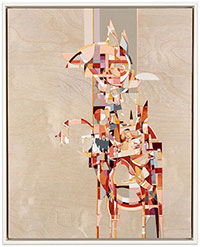
Carolyn V Watson’s new body of work, let’s play pretend, extends her ongoing enquiry into how one might ‘activate the audience’s curiosity by inverting the familiar and thereby offer new readings of the known’. Beyond a childhood game connotation, the exhibition’s title embodies a deeper signification. It arose from her research into the philosophy of the Russian writer, Viktor Shklovsky. His 1917 treatise, Art as Devise, expounds the notion of ‘defamiliarisation’ in the creation and presentation of art forms. Shklovsky asserted that objects deliberately made ‘unfamiliar’ or strange removed the viewer’s ‘automatism of perception’ so that the ‘commonplace’ might be seen as if for the first time. ‘Art exists so that one may recover the sensation of life,’ he declared.
Watson tells that her works also impart an undercurrent of ‘good old make-believe’, where feelings of self-doubt and fear may be allayed by adopting an ‘intensified’ persona. ‘Elaborate costuming and masks have a two-fold objective – they bestow courage to the wearer and arouse curiosity in the onlooker,’ Watson relates. ‘Here a dualism exists; what appears to be one thing can also be quite another’. Her enigmatic characters are ‘playing pretend’ much as an actor on stage inhabits a role.
The creation of Watson’s extraordinary panel paintings was a slow and complex process. She tells that all the pieces were worked on simultaneously to maintain a continuity in which each image immediately informed the other. Her challenge is ever to find that place where the familiar is rendered unfamiliar. ‘All the forms in the panels bear, wear or are masks. They are playing with composition and fabrication – imposters in their own narrative,’ says Watson. ‘A double deer carries the weight of expectation on its own back. A figure surrounds itself with an elaborate fortress of distraction. A pig and a fox-like form re-enact a 2012 sculpture and infer fate. A feed-back loop of a golden calf has now grown into a bull. There’s a mask of cats and red pointed whispers. Four hollow costumes are consumed or camouflaged by roots and undergrowth.’ The incredible intricacy of the shapes and forms within the paintings leads the viewer on a veritable odyssey for discernment.
Beginning with multiple linear tracings of collaged imagery sourced from her research journals, the drawings are subsequently enlarged and transferred onto a birch panel. ‘The paintings evolve from a colour-constructed scaffold, a pattern of flat planes in solid hues. Tonal variation is only employed in the flesh-coloured areas, depth is generated through placement and fine linear work.’ Watson continues, ‘There was no structured planning, instead it became a case of action and response, a push and pull to reveal and conceal. The big blocks of colour are directional arrows, indicating that the panels are an excerpt or snippet of conversation from a larger tale. Circular shapes in the images echo the glass and porcelain spheres in the sculptures. They represent points of reflection and intersection.’
Manifesting a characteristic ‘strangeness’ and ambiguity, Watson’s sculptures reiterate the philosophical intentions of the panel paintings. They were all constructed amid the paintings’ process in a striving to ‘blur physical and mental boundaries’. It was Watson’s intention that the new sculptures should maintain a relationship with those from her previous tall tales and true exhibition. The smaller works recall these earlier pieces in their etched, spindly black body structures, particularly the sculpture, pre-agreed code. Bedecked in a bulky, bull headdress, the entity extends a porcelain hand to the onlooker. This figure and the other kindred creatures are secured into meticulously prepared timber slabs that have been embedded with convex mirrors. The reflected images project ‘a distorted, but true indication of what is beneath the costumed form’.
Watson’s fervour for expressing ‘layers of duality’ is exemplified in the spotlight sculpture. ‘A five-legged deer stands stoic. All is on display and examination is encouraged,’ she declares. But once the removable bone mask has been taken off, the demeanour alters entirely. From an alert, resilient, ‘almost combative’ form it becomes transformed into a blind, cautious, mole-like creature interacting only through touch. Surmounted atop a recycled, rectangular mirror, the intricate textural layers of handstitched sheep leather, felt, doilies and rabbit pelt are reflected in dazzling duplicity.
A pervasive sense of incongruity imbues the forms in the talltales (throwing voices) work. Watson describes it as a sculpture that pays reference to the religious iconography of the Madonna and Child. Three most curious, rabbit-eared entities conjoin upon a rug of white rabbit fur. Emerging from swathes of blackness, the glowing paleness of the porcelain baby’s head and mother’s gesturing hands creates a focal point. ‘The work sits quietly in a fragile intimacy of exchange, a passing of knowledge,’ Watson offers. ‘The talltales title addresses what is said, what is kept and what can be assumed.’
Assembled from animal hip and rib bones, doll parts and doilies, the large wall hanging, mirror (a history of energies), continues the notion of ‘defamiliarisation’. Lavishly adorned with glass spheres, ornate stitching and embellished patterns, Watson relates that the arrangement hangs in honour of the bones that began it and embodies a suggestion of the inner self. ‘An elaborate act/play elucidation, mirror is at once a mask, a relic of ceremony and a female deity,’ she imparts. ‘It is all and anything you believe it to be!’
Hundreds of hours in her Brisbane studio over an 18month period has resulted in a remarkable body of work that most decidedly arrests the viewer’s attention. Shklovsky’s dictum that ‘the process of perception is an aesthetic end in itself and must be prolonged’ has been fulfilled. ‘Let’s play pretend,’ Watson invites. ‘Let there be distracting details, let there be duality and camouflage, let there be colour, line and forms that play with perception. Let’s linger a little longer.’
Receive e-mail updates on our exhibitions, events and more
Subscribe Now